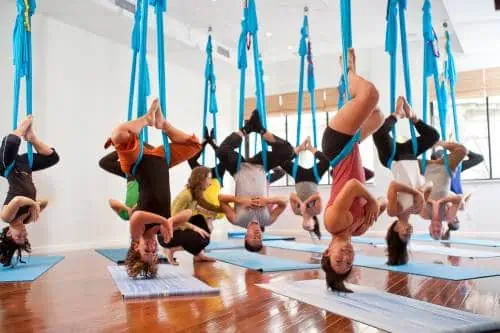Listen to this article:
Key Takeaway
Discover the science-backed benefits of aerial yoga and how it can transform your fitness routine.
If a yogi and a trapeze artist had a baby, it would probably be an aerial yogi. Aerial yoga is a form of antigravity yoga that uses a yoga swing or silk hammock to perform yoga poses while partially or fully levitating above the ground.
This full-body workout has some incredible science-backed benefits that have fitness aficionados and yoga lovers flocking to aerial yoga classes. You can even hang your silks on tree branches or from the ceiling in your home so you can flow anywhere!
Let’s dig into how you can maximize the benefits of aerial fitness.












Contents
Is aerial yoga better than yoga?
Aerial yoga has many of the same benefits as traditional yoga, but it can be better for beginners or people with injuries. While it may look intimidating, many aerial yoga poses are more accessible for people who don’t quite have the flexibility to do those poses on a mat.
The yoga trapeze acts like an added prop or support so you don’t have to hold up your entire body weight. This can make a huge difference for yogis who can’t fully extend their back or fold forward in regular yoga. For example, a heart-opening aerial backbend is extremely restorative and low risk compared to a grounded Bridge Pose on a yoga mat.
Is aerial yoga good for your body?
Aerial yoga helps your entire body to loosen, strengthen, and decompress. Thanks to the inversions and silk supports, this total body workout can have even more health benefits than traditional mat-based yoga.
Performing poses partially or fully in the air releases tension from your spine and muscles while challenging your flexibility, balance, and strength. Although some aerial athletes practice challenging poses with contortionist-style acrobatics, most aerial yoga classes focus on basic postures that improve overall physical health.
You will recognize many aerial workouts as traditional yoga poses with the yoga hammock as a prop. The aerial hammock can even work as an added support in challenging poses like backbends, balances, and inversions. Both beginners and devoted yogis alike may find that an antigravity yoga flow takes their practice to the next level.
Benefits of Aerial Yoga
Aerial yoga is a modern combination of aerial arts, pilates, and traditional yoga poses. The practice has been approved as a form of physical therapy in many countries. Not only is aerial yoga a fun form of exercise, but it also has a range of science-backed physical and mental benefits that may get you addicted to aerial classes.
Back Pain Relief
In general, the number one reason people start yoga is due to back pain. A sedentary lifestyle spent at a desk can put major pressure on your lumbar spine (lower back) and cause chronic pain that inhibits your daily life. Researchers at Boston University School of Medicine found that yoga can alleviate chronic low back pain and improve movement just as well as physical therapy.
But that research is based only on regular mat-based yoga! Aerial yoga takes this back pain relief to a whole different level. These supported poses allow you to stretch open your spine without risking injury or joint pressure. The yoga swing and silks support your whole body weight so you can lay back and relax as your pain melts away. You can even keep your feet comfortably on the floor.
More challenging poses incorporate inversions that dramatically improve spinal and shoulder flexibility. Moreover, an aerial yoga practice helps combat the joint-compressing effects of gravity that cause so much of our culture’s back pain issues.
Researchers have found that hanging upside down in a yoga hammock decompresses the spinal column by lengthening the space between vertebrates. This can help with herniated discs, sciatica, scoliosis, chronic back aches, and more. Just keep in mind that some aerial yoga studios are not equipped to guide people with extreme back injuries. A physical therapist who is licensed in inversion therapy may be more useful.
Stimulate Digestion
If you have trouble with stomach pains, gas, bloating, or other digestive issues, aerial yoga can help with that too! The slight rocking motion of the aerial yoga hammock helps stimulate your digestive organs and helps food move through. Inverted poses are extra beneficial for increasing the blood flow to your intestines. If you want to use your yoga hammock after a big meal, try forward folds and gentle twists that put slight pressure on the abdominal region to encourage regularity.
Improve Blood Circulation
Blood circulation is vital for healthy functioning organs. Studies have found that yoga helps reduce blood pressure and prevent cardiovascular disease. Hanging upside down benefits your entire body by moving blood to your brain and heart. Poses that rotate your body also help to move stagnant blood through your veins and arteries, which improves overall circulation.
When you practice aerial yoga which is more vigorous and core-challenging, you will also notice your heart rate rising and pumping more blood to your working muscles. A study from the American Council on Exercise (ACE) also found that aerial yogis have a significant reduction in risk factors linked to heart disease.
Does aerial yoga help lose weight?
Aerial yoga is a light to moderate-intensity exercise that can burn up to 300 calories in about an hour of practice. More challenging poses can engage every muscle in your body for greater tone, strength, and calorie burning. If your goal is to lose weight with aerial yoga, focus on more active poses like lunges, aerial crunches, and poses that give you a core workout. While it may look like yogis holding a pose in the air aren’t engaging their muscles, they can expend more energy than a cardio workout. This is because you need a lot of engagement in the legs and core muscles to hold yourself up on the yoga silks.
Improved Flexibility
It should come as no surprise that aerial arts improve your flexibility. A 2019 study found that aerial athletes have exceptional flexibility compared to average people. When you take your practice off the mat and into the air, you can stretch more freely with less effort. But being flexible doesn’t just mean you can do cooler tricks, it also helps reduce the risk of injury, improve your posture, and loosen up tension in the body parts so you can feel more limber as you flow through your daily life.
Improved Balance
Finding balance is a challenge in many areas of life. You need more work-life balance or more balance between what you give to others and the time you make for self-care. Aerial yoga can help you with physical as well as mental balance to make you more agile as you meet life’s challenges. The physical aspect of balance is especially helpful for athletes and aging people who need to prevent falls or injuries.
Unlike many standard asanas, aerial yoga can target all of your muscles as you try to balance in the yoga trapeze. You can even boost your balance in a single aerial yoga class! This unique exercise requires that you find a center of gravity as you shift your body in every direction and maintain control against the swaying tendencies of the silk. As you try to find your center, you naturally engage the tiny muscles and microfascia of your limbs as you shake and wobble.
Better Mental Health
If you struggle with anxiety, depression, or chronic stress, aerial yoga can be even better than traditional yoga. Like all forms of yoga, even a single hour-long aerial yoga class can trigger neurotransmitter production (specifically, GABA levels) that make you happier. But more importantly, this practice can combat stress by quite literally turning your mood upside down. Inverted poses are extra useful for creating a more positive outlook, boosting creativity, and releasing chronic worry. Not only is aerial yoga fun and playful, but it is relaxing enough to incorporate into your weekly stress-relief routines.
How often should you do aerial yoga?
For quick results, aerial yoga should be practiced at least once a week. Three times per week is ideal for weight loss and strength building. If you really fall in love with the practice, we recommend installing your own aerial yoga hammock in your house so you can hop on and stretch out any time throughout the day.
Here are the Top 6 Best Aerial Yoga Trapeze, Swings and Hammocks + How to Install Them.
Namaste!
Pop quiz! 🧘🤔
Aerial yoga can help alleviate chronic low back pain.
Aerial yoga is only suitable for advanced yoga practitioners.
Aerial yoga can improve blood circulation in the body.



